Innovations in Kitesurfing: The Starboard Freewing
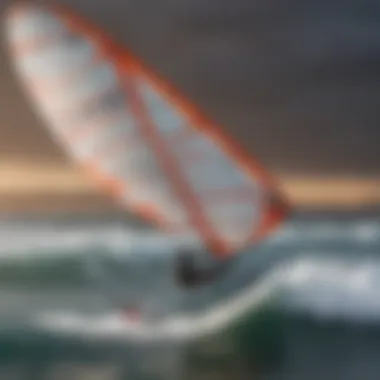
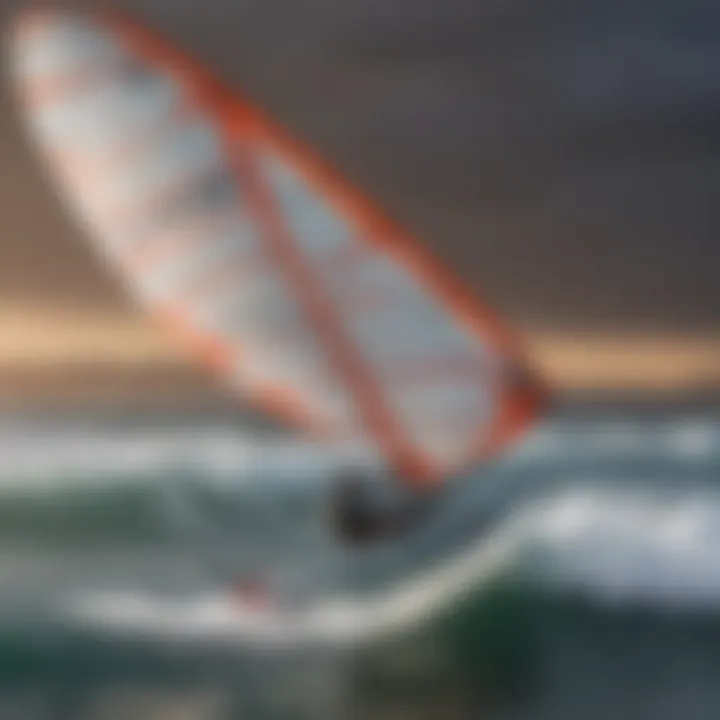
Intro
The world of kitesurfing has witnessed significant innovations over the years, making it crucial for enthusiasts to stay informed. One of the most notable advancements is the Starboard Freewing. This piece of gear pushes the boundaries of technology, combining performance, stability, and ease of use. The Freewing stands out in a crowded market, catering to both beginners and more experienced riders.
In this article, we will explore the Freewing's design features and technical specifications while examining its impact on the kitesurfing community. Additionally, we will compare this product with other popular wings, allowing readers to understand its unique advantages and limitations. Whether you are a novice eager to learn or an experienced kitesurfer looking for the latest gear, this guide aims to assist you in enhancing your kitesurfing experience.
Prelude to Starboard Freewing
The Starboard Freewing represents a groundbreaking addition to kitesurfing gear, carefully tailored for both novices and seasoned riders. Understanding this innovation is crucial for anyone looking to enhance their kitesurfing experience. The Freewing blends advanced technology with user-centric design. It prioritizes performance, stability, and ease of use, making it a game-changer in the world of kite sports.
Background of the Starboard Brand
Starboard is well-known in the watersports industry. Since its inception in 1994, it has continuously set benchmarks for innovation. The brand focuses on sustainability and performance, and its products range from stand-up paddleboards to windsurfing gear. Starboard lives by the commitment to promote an eco-friendly approach while enhancing rider experiences. Its products are often created in collaboration with professional athletes. This ensures that every item, including the Freewing, meets high standards in performance and durability.
Overview of the Freewing Concept
The Freewing concept introduces versatility to kitesurfing. It combines characteristics of traditional kites with the advantages of hand-hold sailing wings. The result is a tool that offers freedom for riders of all skill levels. Many kitesurfers appreciate the stability and ease of control that the Freewing provides. Its lightweight construction aids in efficient maneuvering and sailing. The Freewing enables riders to tackle diverse water conditions. This adaptability aligns with the dynamic needs of kitesurfers, thereby enriching their engagement with the sport.
Design Features of the Starboard Freewing
The design features of the Starboard Freewing hold significant importance as they directly affect performance and user experience. Understanding these elements can help potential buyers and riders make informed choices. The Freewing is crafted with specific materials, exhibits various shapes and sizes, and incorporates efficient inflation and deflation mechanisms. Each of these aspects plays a crucial role in the overall functionality of the wing.
Materials Used in Construction
The materials used in the construction of the Starboard Freewing are selected to enhance durability while maintaining lightweight characteristics. High-quality fabrics such as ripstop nylon and polyester are common choices. These materials offer resistance against tears and abrasions, which is critical for kitesurfing gear that faces harsh water and wind conditions.
Additionally, the presence of reinforced seams and a robust leading edge contribute to the strength of the Freewing. These design choices ensure that the wing does not easily succumb to wear and tear over time.
Furthermore, the use of eco-friendly materials signifies Starboard's commitment to sustainability. Riders can appreciate this effort, knowing they are using gear that minimizes environmental impact.
Shape and Size Variations
The Starboard Freewing is available in multiple shapes and sizes, allowing it to cater to different rider preferences and skill levels. The variation in wing shapes affects lift, speed, and maneuverability. For instance, larger wings tend to provide more lift, making them easier for novice riders to control, especially in lighter winds.
Conversely, smaller wings are designed for advanced kitesurfers looking for increased performance and agility. These riders often prefer wings that allow for sharp turns and quick repositioning. The ability to choose from a range of sizes ensures that the Freewing meets the needs of a wide audience.
Inflation and Deflation Mechanisms
Inflation and deflation mechanisms are essential aspects of the Freewing's design. Efficient systems not only save time but also enhance safety. The Starboard Freewing features a one-way valve mechanism that allows for quick inflation with minimal effort. This is particularly beneficial during those moments when an immediate launch is needed, enabling riders to get in the water faster.
Deflation is just as important. The Freewing includes a simple and effective deflation system that allows riders to pack their gear conveniently after use. This ease of packing reduces the hassle often involved in transitioning from riding to storage.
"The quality of materials and the thoughtful design approach enhances both performance and sustainability in the watersports arena."
Whether you are a novice or an expert, these aspects of the Freewing add significant value to the overall kitesurfing experience.
Performance Analysis of the Freewing
Performance analysis of the Starboard Freewing is crucial to understanding its capabilities in various settings. This section assesses how effectively the Freewing performs in real-world situations, which influences the overall experience of kitesurfing. Evaluating performance is essential for both beginners and seasoned riders seeking optimal performance levels. Key factors include speed, maneuverability, stability in diverse wind conditions, and efficiency across different water conditions.
Speed and Maneuverability
Speed is one of the primary attributes that kitesurfers evaluate when considering a wing. The Starboard Freewing excels in speed thanks to its aerodynamic design and lightweight materials. These features allow riders to achieve considerable velocity with minimal effort. Furthermore, the maneuverability of the Freewing is impressive. Riders find that sharp turns and quick adjustments can be made seamlessly, which is essential for navigating changing conditions. This agility allows for an engaging and dynamic riding experience, making it suitable for various skill levels.
Stability in Varied Wind Conditions
Stability in different wind conditions is another critical aspect. The design of the Starboard Freewing takes into consideration irregular wind patterns. Riders have reported that the Freewing maintains its stability even during gusty weather. This reliability allows kitesurfers to focus on their performance rather than worrying about the wing’s handling. Furthermore, consistent stability reduces the risk of accidents, providing an added layer of safety during rides. Riders can confidently progress their skills in changing conditions with a well-stable wing like the Freewing.
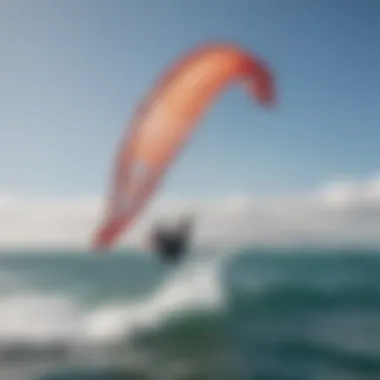
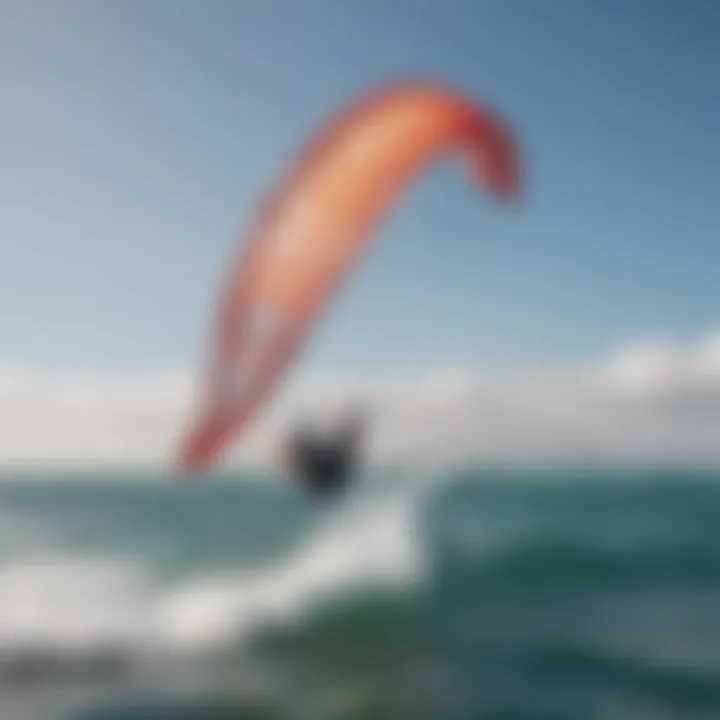
Efficiency in Different Water Conditions
Efficiency in water conditions further establishes the Starboard Freewing as a superior choice in the kitesurfing market. It performs well in both flat water and choppy surfaces, adapting effectively to varying environments. Users have noted the wing’s ability to maintain lift even in less than ideal conditions, which enhances their overall riding experience. This efficiency translates to less energy expended during sessions, allowing for prolonged periods of fun without excessive fatigue.
"The Freewing delivers dependable performance across the board, whether you are looking for speed or stability."
In summary, the performance analysis of the Starboard Freewing highlights its strengths in speed, maneuverability, stability, and efficiency. These attributes make it an appealing choice for kitesurfers at all levels.
Comparison with Other Kitesurfing Wings
In the realm of kitesurfing, understanding how different wings stack up against one another is crucial for every rider. The Starboard Freewing doesn’t exist in a vacuum. Comparing it with other kitesurfing wings allows for a well-rounded perspective on performance, design innovations, and user preferences. This analysis emphasizes not only competitive advantages but also the necessary considerations that come with choosing the right gear for varied conditions. Rider experience, skill level, and specific needs must be taken into account when evaluating how the Freewing aligns with its competitors.
Key Competitors in the Market
The kitesurfing market features several notable wings that are direct competitors to the Starboard Freewing. Among these, the Slingshot Hover Glide, F-One Swing, and Naish Wing-Surfer have gained recognition.
- Slingshot Hover Glide: Known for its durability and excellent lift, making it a favored choice for many intermediate and advanced riders.
- F-One Swing: Praised for its lightweight design and ease of use, appealing primarily to novice kitesurfers.
- Naish Wing-Surfer: Offers versatility and stability in diverse conditions, appealing to a wide demographic of riders.
These competitors present unique features, catering to various aspects of kitesurfing performance and rider preferences.
Advantages of the Starboard Freewing
The Starboard Freewing has several advantages that make it stand out in the current kitesurfing landscape. First, its stability across a range of wind conditions is commendable. Riders report consistent control even in challenging scenarios, reducing the likelihood of mishaps. Additionally, the inflation mechanism proves swift and effective, allowing for rapid setup and takedown, which is invaluable for riders who want to maximize their time on the water.
Another advantage is user comfort. The ergonomics of the wing facilitate easy handling and maneuverability. Many users notice that the weight distribution enhances their overall experience, promoting longer rides without excessive fatigue. Furthermore, feedback from riders emphasizes the Freewing’s responsiveness during turns and its ability to slice through water, making it a thrilling option for more dynamic riding styles.
Disadvantages and Considerations
Despite its many strengths, the Starboard Freewing has some disadvantages that potential buyers should consider. One notable issue is its price point. Compared to some rivals, the Freewing can be more expensive, which might deter novice riders or those on tighter budgets. Additionally, some users have reported a learning curve associated with the wing's handling. While its stability is a plus, it may take time for less experienced riders to harness its full potential.
Moreover, while the Freewing excels in many conditions, it may not perform as well in extremely gusty winds compared to certain competitors. Riders in areas where conditions change rapidly should factor this into their decision.
In summary, while the Starboard Freewing presents itself as a formidable choice, understanding its competition provides critical insights into its strengths and areas needing improvement. The decision on which kitesurfing wing to choose ultimately comes down to individual rider preferences, skill levels, and the specific circumstances of their kitesurfing experience.
User Experiences and Feedback
User experiences and feedback are essential to understanding the real-world impact of the Starboard Freewing on riders. Novice users offer a fresh perspective, while seasoned kitesurfers bring knowledge from extensive practice. Insights gathered from these two groups can guide potential buyers and improve the product itself. The importance lies not only in personal stories but also in identifying common themes in performance, usability, and overall satisfaction.
Testimonials from Novice Riders
Novice riders often provide the most valuable feedback regarding accessibility and learning curve. Many beginners praise the Freewing for its stability and ease of use. This is particularly important for those new to kitesurfing, as the right gear can significantly enhance the learning process.
"The first time I tried the Freewing, I felt balanced and in control. It made learning to kitesurf much more enjoyable," said one novice rider.
Additional testimonials highlight that the Freewing's design reduces the intimidation factor. Many novices express less anxiety when attempting their first maneuvers. Some key points raised by novices include:
- Stable lift: Easy to control and keep in the air.
- Simple setup: Quick inflation and deflation.
- Responsive feedback: Clear indication of what adjustments need to be made.
Overall, novices appreciate gear that promotes confidence while they learn.
Insights from Experienced Kitesurfers
Experienced riders add depth to the feedback landscape. Their insights focus more on performance in challenging conditions and long-term durability. Many seasoned kitesurfers have noted that the Freewing excels in a variety of wind conditions, allowing longer sessions without compromise.
"The Freewing holds its own against more established brands. Its performance surprised me during high wind days," shared an experienced kitesurfer.
These testimonials frequently emphasize:
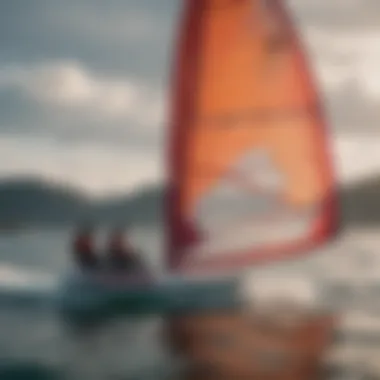

- Durability: High-quality materials withstand usage.
- Versatility: Malfunctions are rare even in rough water conditions.
- Enhanced techniques: The design aids advanced maneuvers and tricks.
These comments illustrate how the Freewing meets higher performance expectations, making it a valuable addition to any serious kitesurfer's gear.
Common Issues and Solutions Identified
While feedback tends to be positive, all products have areas for improvement. Users have identified certain issues that can arise with the Starboard Freewing. Common concerns include:
- Initial difficulties with handling: Some riders reported struggles with the wing's responsiveness in the early stages.
- Pack weight: A few users noted that the Freewing may feel heavier compared to other models when packed for transport.
For these drawbacks, solutions have emerged from the community:
- Handling tips: Experienced riders have created tutorials, which novices can follow to improve their skill level.
- Transport equipment: Recommendations for specialized bags or carts can alleviate discomfort during transport.
Recognizing these common issues is vital for future designs and adjustments. In the kitesurfing community, learning from experiences enables continuous progress.
Technical Specifications of the Freewing
The technical specifications of the Freewing are crucial for understanding its performance and suitability for various riders. These specifications encompass the size and dimensions of the wing, its weight and portability, as well as rider recommendations tailored for different skill levels. Each detail contributes to the overall effectiveness of the Freewing while catering to the preferences of kitesurfers.
Wing Areas and Aspect Ratios
The wing area and aspect ratio are two key factors influencing a wing's performance. The wing area refers to the total surface area of the wing, which directly affects lift and power. A larger wing area tends to perform better in light winds, providing the necessary uplift for the rider. Conversely, a smaller wing area is advantageous in stronger winds, offering better control.
Aspect ratio, on the other hand, is the ratio of the wing's width to its height. A higher aspect ratio leads to improved aerodynamics, resulting in reduced drag. This is beneficial for speed and performance, making it easier to maneuver and carve through the water.
For the Starboard Freewing, the different models typically feature a range of wing areas and aspect ratios, allowing users to choose what best fits their riding style and local conditions. For instance, riders looking for versatility may opt for a model with a balanced aspect ratio, while performance-focused riders can benefit from wings with higher ratios.
Weight and Pack Dimensions
Weight plays a significant role in how a kitesurfer manages their gear. A lightweight wing ensures easier handling, especially during transport and setup. The Starboard Freewing is designed with lightweight materials, optimizing its weight without compromising durability.
Pack dimensions are another important aspect. A compact, easily stowed wing can enhance a kitesurfer's experience, particularly for those who travel to various locations or need to store their gear in confined spaces. Starboard has taken this into account, making the Freewing easy to deflate and fold neatly without taking up too much volume. The ability to spend less time packing and unpacking allows riders to focus more on the water and less on the logistics.
Recommended Rider Sizes
Choosing the right wing size is crucial for a satisfactory kitesurfing experience. The Starboard Freewing offers recommendations based on rider weight and conditions. Each size accommodates a range of weights, providing a guideline for optimal performance. Novice riders generally require a larger wing to achieve sufficient lift, while experienced riders can opt for smaller wings tailored to their advanced skills.
Understanding these recommendations will help kitesurfers select the most suitable Freewing model, ensuring the best balance between stability and performance. This adaptability makes the Freewing appealing to a diverse group of riders, from novices to seasoned experts.
"Choosing the right specifications can dramatically influence your kitesurfing experience. Understanding these details will enhance both your safety and enjoyment on the water."
In summary, the technical specifications of the Starboard Freewing serve as a roadmap for riders. By paying attention to wing areas, aspect ratios, weight, pack dimensions, and recommended sizes, users can find a match that amplifies their overall kitesurfing enjoyment.
Technological Innovations
Technological innovations are at the heart of the Starboard Freewing. This section focuses on how advancements in design and engineering enhance the overall kitesurfing experience. Understanding these innovations helps riders make more informed choices about their equipment, especially for those who want both performance and safety from their wings.
Innovative Wing Design
The Starboard Freewing features an innovative wing design that significantly contributes to its performance and stability on the water. This design is characterized by its unique shape and construction methods. The aspect ratio has been optimized to enhance lift and reduce drag. A higher aspect ratio allows for better upwind performance, making it easier for riders to progress against the wind with less effort.
Additionally, the materials used in the wing construction are lighter and stronger than traditional fabrics. This results in improved durability without compromising weight. The combination of advanced stitching techniques and cutting-edge materials also minimizes the risk of tearing, which is a common challenge in kitesurfing gear.
Moreover, the wing’s leading edge has been designed for improved aerodynamic efficiency. A rounded leading edge reduces turbulence and allows the Freewing to reach higher speeds smoothly. Riders can enjoy enhanced maneuverability, making complex tricks more achievable.
Integration of Performance Metrics
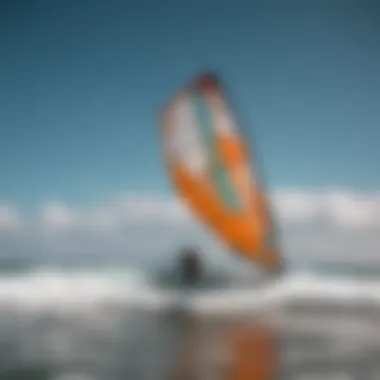
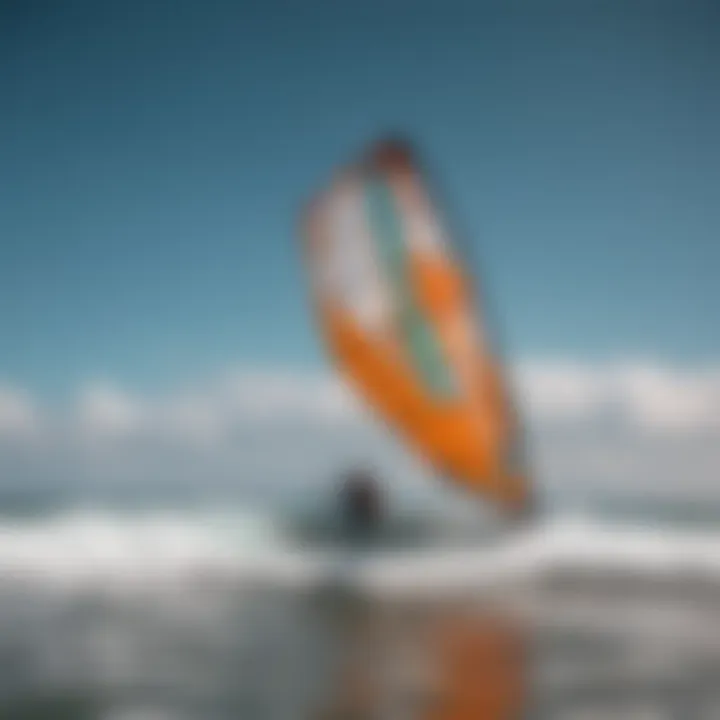
Another notable innovation of the Freewing is the integration of performance metrics. With modern technology, riders can now connect their wings to apps or devices that track real-time data. This includes speed, wind direction, and wing angle, which allows for precise performance analysis.
Integrating these metrics offers several advantages. Firstly, kitesurfers can assess their performance directly. They can understand their strengths and weaknesses and improve their techniques accordingly. Secondly, the data collected feeds into training programs, helping riders maximize their potential on the water.
Furthermore, these performance metrics help in weather assessment. By tracking changes in wind speed and direction during a session, riders can make informed decisions on when to alter their riding style or even when to call it a day.
These technological advancements in the Starboard Freewing illustrate the intersection of sport and technology, enhancing the kitesurfing experience while ensuring safety and efficiency.
Safety Features and Best Practices
Safety features in kitesurfing gear like the Starboard Freewing are crucial for both novice and experienced riders. Understanding these features significantly enhances the user's overall experience and minimizes risks. The Freewing integrates various built-in safety mechanisms designed to protect against accidents during use. It is essential for kitesurfers to not only be aware of these features but also adhere to best practices to ensure a safe riding experience.
Built-in Safety Mechanisms
The Starboard Freewing is equipped with multiple built-in safety mechanisms to help prevent accidents and injuries. These include:
- Quick Release System: This feature allows riders to quickly detach from the wing in case of an emergency. It is essential for reducing the risk of being dragged or control loss in challenging conditions.
- Automatic Inflation: The wing is equipped with an automatic inflation system that ensures the wing remains operational after accidents. This helps riders regain control more easily after a mishap.
- Durable Materials: The materials used in the construction of the Freewing contribute to its resilience against tears and punctures. High tenacity fabrics reduce the chances of equipment failure while on the water.
- Safety Leash: A safety leash connects the rider to the wing. This mechanism ensures that the rider remains attached to the equipment, minimizing the risk of losing the wing in strong winds.
These elements play a vital role in enhancing rider safety and confidence while kitesurfing.
Recommended Safety Guidelines
To complement the built-in safety mechanisms, a set of recommended guidelines further ensures a safe kitesurfing experience. Kitesurfers should consider the following practices:
- Check Equipment Regularly: Before heading out, inspect the Freewing for any signs of damage, wear, or defects. Any malfunction can lead to serious consequences.
- Know the Weather Conditions: Understanding wind forecasts and water conditions is crucial. Avoid kitesurfing in high winds or storms, especially if you are a beginner.
- Wear Appropriate Safety Gear: Equip yourself with a helmet, impact vest, and suitable footwear. Protective gear can significantly reduce injuries in case of accidents.
- Practice Self-Rescue Techniques: Familiarize yourself with self-rescue methods. This knowledge can save lives in an emergency, particularly in rough waters.
"Safety in kitesurfing is not just about equipment but also about preparation and awareness."
By adhering to these guidelines, kitesurfers can enhance their safety and make the most of their wings while enjoying their time on the water.
The Future of Wing Kitesurfing
The future of wing kitesurfing holds much potential for evolution and broader acceptance in the water sports community. Innovations in design and technology are not only enhancing the performance of wings like the Starboard Freewing but also expanding their appeal to different user groups. This section discusses significant emerging trends and provides predictions for the market growth of this exciting sport.
Emerging Trends in Wing Design
Wings are evolving rapidly. Notable trends include the focus on lightweight materials and smart design refinements. Manufacturers are integrating advanced polymers that provide both durability and responsiveness. This is crucial, as kitesurfers require equipment that can withstand harsh conditions while maintaining optimal performance.
Design modifications to wing shapes are also prevalent. New shapes are being tested to enhance aerodynamics and make wings more user-friendly. Wider wings are popular for beginners to enhance stability. Conversely, advanced riders are looking for wings that allow for quick maneuverability without sacrificing speed. Different configurations are being produced to cater to these varying preferences.
Additionally, sustainability is creeping into design conversations. Eco-friendly materials and manufacturing processes are becoming more prominent. Customers are increasingly aware of the environmental impact of their gear.
Predictions for Market Growth
The kitesurfing market is on an upward trend, and wing kitesurfing is expected to lead this growth. Analysts predict a rise in interest, particularly among young athletes looking for new challenges. The accessibility of wings, both in terms of ease of use and price, supports this growth.
Current trends suggest that the wing kitesurfing segment could see a year-on-year growth rate of 15-20% over the next few years. This surge is due to advancements in technology, which will continue to enhance the riding experience.
Moreover, as the sport becomes more mainstream, events and competitions focusing on wings are likely to proliferate. This could cultivate a larger community, further driving interest and participation. Additionally, retail opportunities are expected to expand, making wings more accessible than ever before.
"the future is promising, and as innovation continues, the wings will evolve to meet the demands of all riders, from novices to professionals and impact the overall growth of the kitesurfing community."
In summary, the future of wing kitesurfing is bright. By embracing innovative designs and sustainable practices, manufacturers and riders alike will encourage the sport's growth. The evolving landscape of wing design and anticipated market growth makes it an exciting time for enthusiasts.
Culmination
In this exploration of the Starboard Freewing, it becomes evident that this equipment marks a notable advancement in kitesurfing gear. It not only enhances the sport for seasoned participants but also makes the experience more accessible for newcomers. The kitesurfing community benefits from such innovations, as they foster an environment where both performance and user experience are prioritized.
Summary of Key Insights
The investigation into the Starboard Freewing yields several critical findings. Among them are the advanced materials utilized in its construction, which contribute to its durability and performance. The design features, like various shape and size options, cater to a range of riding styles and preferences. Performance analysis reveals a capacity for swift maneuverability and impressive stability across diverse wind conditions. Feedback from users highlights the positive reception among novices and experts alike. It also points out some issues that can be addressed, offering avenues for future development.
Final Thoughts on the Starboard Freewing
Ultimately, the Starboard Freewing signifies a shift in kitesurfing technology that cannot be overlooked. The blend of functionality, safety, and user-centric design creates a compelling product in a competitive market. As the sport evolves, the impact of innovations like the Freewing will become ever more pronounced. For those who are eager to elevate their kitesurfing experience, understanding these developments is essential. The future of kitesurfing may very well be shaped by the advancements and lessons learned from the Starboard Freewing.







